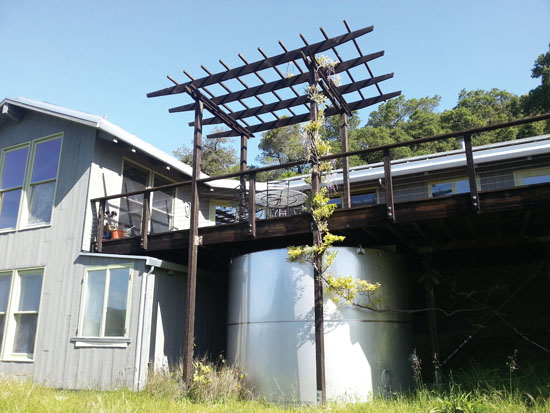
| ||||||
"Last year we held onto the rainwater, to use domestically," Jones said. That worked out especially because of the drought. "By October, the spring can be quite low." The spring - the
literal kind, with water - gets down to trickling out about 50 gallons per day. That could be cause for worry if you have to have water, not just for people but for livestock and plants.
According to the state Water Quality Control Board, the average water use by us Californians is about 80 gallons per day per person, so if you have, say, two people in the house, you can do the math. Dishwashing and showering and flushing the toilet just add up to that much more water going down the drain. If two parents have two kids, they're looking at an average 320 gallons, and it's often more.
Yet while the "if it's yellow it's mellow, if it's brown flush it down" moniker is the catch-phrase of some households, more people are using rainwater to ameliorate their public utilities' outflow of treated water in place of water that doesn't really need to be treated.
"You can use the rainwater for anything," said Lee Lawrence, who lives on the outskirts of Moraga and has about a dozen barrels. "It's perfectly okay to drink."
(Some at the Water Quality
Control Board disagree that rainwater can be consumed without treatment.
The Board say it depends on the quality of the water, for which the board does not currently test, and the safety of its catchment and storage facilities, as well as the length of time the water spends in the tank.)
The use of any water - especially watching the skies pour down in March and April - has many Lamorindans starting to use rainwater catchment systems, so that when the rain comes down, it doesn't just flow downhill or seep into the ground. Instead it gets caught up in barrels and tanks and troughs so that livestock, gardens and even toilets get water targeted for a purpose, and doesn't come through East Bay Municipal Utility District's metered system.
"We use it for a lot of things," Lawrence said. "We have rain barrels coming down right in front of the gutters."
In many parts of Colorado, catching rainwater is illegal. Ranchers and farmers need all the runoff from suburban and borderline properties to flow off the roofs of houses and into the watershed. Many families find it abhorrent that the rain that falls on their roofs is owned by somebody else. Such conflicts illustrate that water is becoming a more politicized issue.
Less than 3 percent of all the water on earth is fresh water. That is correct: less than 3 percent. Predictably, in a drought the precious amount of rainwater is being harvested by more households in order to water gardens, trees, or even for drinking.
"We drink rainwater here, too" Jones said.
Jones even put a metal roof on her house to ensure more "clean" delivery into the directed rain gutters on the part of the house that rain showers feed most directly into her big tank. She waters a garden and fruit trees, and waters her livestock and birds. "It's pretty simple," she said.
For more information on rainwater catchment systems, visit the American Rainwater Catchment Systems Association at www.arcsa.org.

Reach the reporter at:
